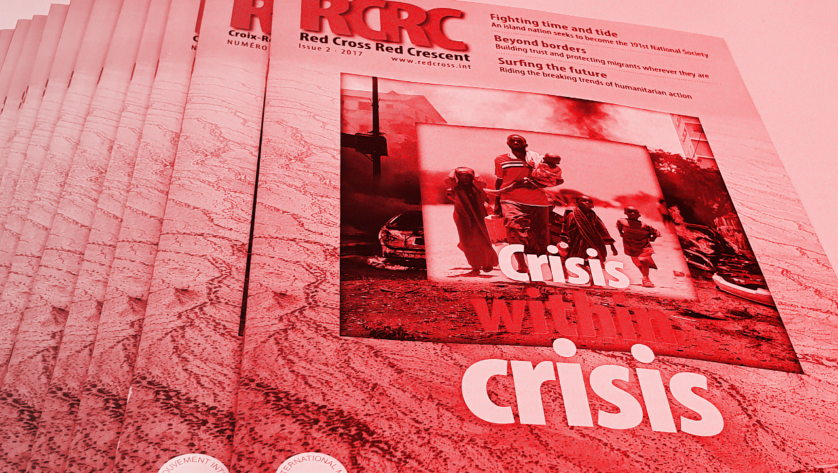There is a growing chorus of voices — disruptors and seasoned operators — arguing that the current humanitarian ecosystem is no longer fit for purpose, no longer able to meet present needs, let alone be ready for the future.
Climate change, mass migration, more intense and frequent natural disasters, protracted conflicts, cyber security threats, emerging pandemics, famine — fast forward ten years or so and all these present day challenges will be compounded by a world one degree warmer, with 1 billion more people, and rapidly growing resource and wealth inequality.
If the system isn’t working now, hold on tight…
In fairness, the system is trying to repair itself. Following the World Humanitarian Summit in May 2016, political and humanitarian leaders made promises and commitments to put humanity first — to prevent and end conflict, reach the most vulnerable, mitigate and reduce the effects of large disasters, and uphold international humanitarian law.
One of the most significant outcomes was an agreement that became known as “The Grand Bargain,” under which donors agree to make funding more flexible, predictable and longer term while humanitarian actors were compelled to get their houses in order in a number of key areas.
One of the key demands on humanitarian organizations is that they better coordinate their actions, reduce duplication and therefore improve efficiency. While these are not new ideas, the Grand Bargain was the first time these promises were codified in a high-level attempt at humanitarian reform.
This kind of coordination and collaboration is easier said than done. Many humanitarian organizations, including Movement components, are locked into short-term thinking in both our politics and our business cycles that can lead to decisions that are at odds with the best humanitarian outcomes. This thinking is sometimes driven by demands of financing, cost recovery, fundraising competition, donor obligations, or the legacy of traditional roles and responsibilities — habits that are hard to break.
Architecture of isolation
Despite attempts to improve coordination and cooperation over the years, the humanitarian system can be largely characterized by a collection of isolated contributions or impacts by individual organizations, a dynamic that was well documented by a 2011 study by Kania and Kramer in their paper to the Stanford Social Innovation Review.
Here’s how it tends to work: in order to make a particular goal in their area of interest, donors try to ascertain which organizations make the greatest, contribution toward that specific goal and they fund accordingly, irrespective of whether more could be achieved through a more collective approach.
The aid cyclone
A recent example is Myanmar, which has only relatively recently seen the re-introduction of multiple aid agencies. In 2014 and 2015, aid agencies separately delivered nearly 5,000 workshops, launches and events, which overwhelmed and largely disempowered local officials, according to former Division Head for AusAID, Richard Moore.
Within the International Red Cross and Red Crescent Movement, there are eight actors implementing projects in Myanmar. In many countries, there are many more. In the Philippines, there were at least 15 partner national societies with in-country offices at the peak of the Typhoon Haiyan response.
Within these environments, implementing organizations compete to demonstrate how their individual activities produce the greatest effect and are then judged on their own isolated potential to achieve impact. According to Kania and Kramer, this leads organizations to work at odds with each other and exponentially increase overall resource needs.
We at the Australian Red Cross are familiar with this pattern as we work in a region with high exposure to natural disasters. In 2015 and 2016, Vanuatu and Fiji were hit by the worse cyclones in their respective histories. Over half of the population of Vanuatu was affected, costing 60 per cent of its GDP.
The response to the cyclones in Vanuatu, with its population of only 260,000 people, overwhelmed local institutions and communities. Although some 130 separate agencies responded and multi-million dollar international appeals were launched, families on the outer islands waited weeks to get something as simple as a tarpaulin and tools to keep out the rain. Local organizations felt by-passed by the international system and, within the Red Cross Movement, there were challenges related to multi-layered decision-making and poor coordination.
We need culture change
What’s needed to address these kind of recurring cyclones of aid are not simply new coordination mechanisms — although that may be part of the solution — but rather a sector-wide culture change that rewards collective impact over isolated effort. For the International Red Cross and Red Crescent Movement — a complex network of interconnected yet autonomous entities acting in multilateral, bilateral and sometimes unilateral ways — this is especially relevant.
Are we ready for such a culture change? Is the sector, including the Red Cross and Red Cross Movement, too stuck in the isolated impact mindset, caught up in internal ‘turf versus trust’ battles and failing to put best humanitarian outcomes first?
Before you answer, let’s take a look at what that new ‘culture’ might look like. In various parts of the world, new approaches and models are being tested that offer insight in how a more collective model might work. Such approaches tend to have a few common characteristics: multiple partners band together around shared agendas, outcomes and measures.
For their part, partners need to operate within a framework of clear roles and responsibilities where they are contributing to, but not owning, an overall agenda. It’s about knowing which partners are best placed to act on certain things, when and where to do things jointly or when to let go. At the same time, there needs to be a common understanding of and respect for each actor’s operating principles and intent and robust due diligence.
In Australia and other countries, we are seeing a significant growth in collective-impact approaches toward complex social problems, from efforts to reduce recidivism among those caught in the criminal justice system, to cradle-to-career child development, to poverty reduction and addressing homelessness.
Such efforts tend to be successful when activity is mutually reinforcing, where there is continuous communication and a backbone support organization that takes the lead on coordination, not implementation. What is stopping us adopting the same principles within our international work and working to more successfully push in the same direction?
At Australian Red Cross, we have recently established an Impact Prospectus that will bring multiple partners together to help grapple with complex humanitarian challenges. We are adopting collective impact principles and are trying to rethink the way disasters are managed in the Pacific.
We are also seeking to combine the strengths and resources from the technology, science, entrepreneurship, finance and law industries with those of local organizations, Australian Red Cross and international non-governmental organizations. It is a step towards re-orientating our entire business model to be better prepared for the future.
Leveraging big change
We are only at the beginning of this endeavour, but are challenging existing partnership and business models, engaging with new actors and technologies and bringing in new ways of thinking. The idea is to leverage a bigger change than we could achieve on our own. We have known for some time that more intelligent aid will need the know-how and expertise of others — the private sector, INGOs, governments — together with the unique reach of the Red Cross.
Now, we have to ask ourselves new questions: are we pursuing these relationships in a co-creation manner rather than seeing the private sector as simply investors into our part of a fragmented system? Are we really being driven by best humanitarian outcomes or simply aiming for the best we can achieve on our own?
With these questions in mind, we believe the humanitarian ecosystem more broadly, and the Red Cross’s role within it, needs a radical rethink. We must start taking a longer-term, more systemic approach to collaboration. It means being brave and not clinging to outdated modalities and habits. It requires new forms of investments and seeking out non-traditional partners.
In this sense, the Grand Bargain asks us to take a leap of faith. It asks us give up a certain amount of our turf — and a certain means of easily measurable but isolated impact. In exchange, we stand to achieve something greater: a share in a much more transformative and far greater collective impact.
 Red Cross Red Crescent magazine
Red Cross Red Crescent magazine 








 Tech & Innovation
Tech & Innovation Climate Change
Climate Change Volunteers
Volunteers Health
Health Migration
Migration